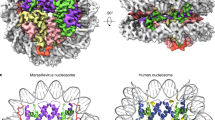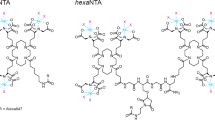Abstract
Numerous nucleic acid sequence motifs have been identified as transcriptional regulatory elements, and proteins involved in the control of gene replication and transcription have been successfully purified using nucleic acid affinity procedures1–5. We have developed an assay that allows direct characterization of cellular proteins binding to the enhancer element of the human immunodeficiency virus (HIV), which is analogous to immunoprecipitation techniques. In extracts of H9 cells, a human CD4+ lymphoblast line clonally selected for its ability to support HIV replication6,7, we find a class of proteins that interact specifically with the HIV enhancer. Reproducible high-resolution, two-dimensional gel electrophoresis has allowed us to resolve these proteins into two major sets. One set is common to H9 cells, two human B-lymphoblast lines, and a phytohaemagglutinin (PHA)-stimulated human CD4+ lymphoblast line (Jurkat). A second set of proteins is found only in H9 cells. Thus, with this assay we have identified HIV enhancer-binding proteins that are constitutive or inducible and that are cell-type specific.
This is a preview of subscription content, access via your institution
Access options
Subscribe to this journal
Receive 51 print issues and online access
$199.00 per year
only $3.90 per issue
Buy this article
- Purchase on Springer Link
- Instant access to full article PDF
Prices may be subject to local taxes which are calculated during checkout
Similar content being viewed by others
References
1. Rosenfeld, P. J. & Kelly, T. J. / biol Chem. 261, 1398-1408 (1986). 2. Briggs, M. R., Kadonaga, J. T., Bell, S. P. & Tjian, R. Science 234, 47-52 (1986). 3. Kasher, M. S., Pintel, D. & Ward, D. C. Molec. cell. Biol. 6, 3117-3127 (1986). 4. Chodosh, L. A., Carthew, R. W. & Sharp, P. A. Molec. cell. Biol. 6, 4723-4733 (1986). 5. Grabowski, P. J. & Sharp, P. A. Science 233, 1294-1299 (1986). 6. Popovic, M. et al. Science 224, 497-500 (1984). 7. Gallo, R. C. & Montagnier, L. Nature 326, 435-436 (1987). 8. Rosen, C. A., Sodroski, J. & Haseltine, W. A. Cell 41, 813-823 (1985). 9. Muesing, M., Smith, D. H. & Capon, D. J. Cell 48, 691-701 (1987). 10. Siekevitz, M. et al. Science (in the press). 11. Tooze, J. in The Molecular Biology of Tumor Viruses (Cold Spring Harbor Laboratory, New York, 1973). 12. Boshart, M. et al. Cell 41, 521-530 (1985). 13. Nabel, G. & Baltimore, D. Nature 326, 711-713 (1987). 14. Maniatas, T., Fritsch, E. F. & Sambrook, J. Molecular Cloning, a Laboratory Manual (Cold Spring Harbor Laboratory, New York, 1982). 15. Jones, K. A., Kodonaga, J. T., Luciw, P. A. & Tjian, R. Science 232, 755-759 (1986). 16. Forster, A. C., Mclnnes, J. L., Skingle, D. C. & Symons, R. H. Nucleic Acids Res. 13, 745-761 (1985). 17. Dignam, J. D., Lebovitz, R. M. & Roeder, R. G. Nucleic Acids Res. 11, 1475-1489 (1983). 18. Laemmli, U. K. Nature 227, 680-685 (1970). 19. Garrels, J. I. Meth. Enzym. 100B, 411-439 (1983). 20. Zagury, D. et al. Science 231, 850-853 (1986). 21. Harada, S., Koyangi, Y., Nakashima, H., Kobayashi, N. & Yamamoto, N. Virology 154, 249-258 (1986). 22. Sen, R. & Baltimore, D. Cell 46, 705-716 (1986). 23. Sen, R. & Baltimore, D. Cell 47, 921-928 (1986). 24. Nitta, M. et al. Blood 66, 1053-1061 (1985). 25. Garner, N. M. & Revzin, A. Nucleic Acids Res. 9, 3047-3060 (1981). 26. Fried, M. & Crothers, D. M. Nucleic Acids Res. 9, 6505-6525 (1981). 27. Strauss, F. & Varshavsky, A. Cell 37, 889-901 (1984). 28. Oilman, M. Z., Wilson, R. N. & Weinberg, R. A. Molec. cell. Biol. 6, 4305-4316 (1986). 29. Kaufman, J. D. et al. Molec. cell. Biol. 7, 7759 (1987). 30. Tong-Stavksen, S. E., Luciw, P. A. & Peterlin, B. M. Proc. natn. Acad. Sci. U.S.A. 84, 6845 (1987).
Author information
Authors and Affiliations
Rights and permissions
About this article
Cite this article
Franza, B., Josephs, S., Gilman, M. et al. Characterization of cellular proteins recognizing the HIV enhancer using a microscale DNA-affinity precipitation assay. Nature 330, 391–395 (1987). https://doi.org/10.1038/330391a0
Received:
Accepted:
Issue Date:
DOI: https://doi.org/10.1038/330391a0
This article is cited by
-
HIV integration and the establishment of latency in CCL19-treated resting CD4+ T cells require activation of NF-κB
Retrovirology (2016)
-
Reciprocal regulation of the nuclear factor of activated T cells and HIV-1
Genes & Immunity (2004)
-
Identification of a novel cell-type and context specific enhancer within the negative regulatory element of the human immunodeficiency virus type 1 long terminal repeat
Archives of Virology (1994)
-
Cloning of an NF-κB subunit which stimulates HIV transcription in synergy with p65
Nature (1991)
Comments
By submitting a comment you agree to abide by our Terms and Community Guidelines. If you find something abusive or that does not comply with our terms or guidelines please flag it as inappropriate.



